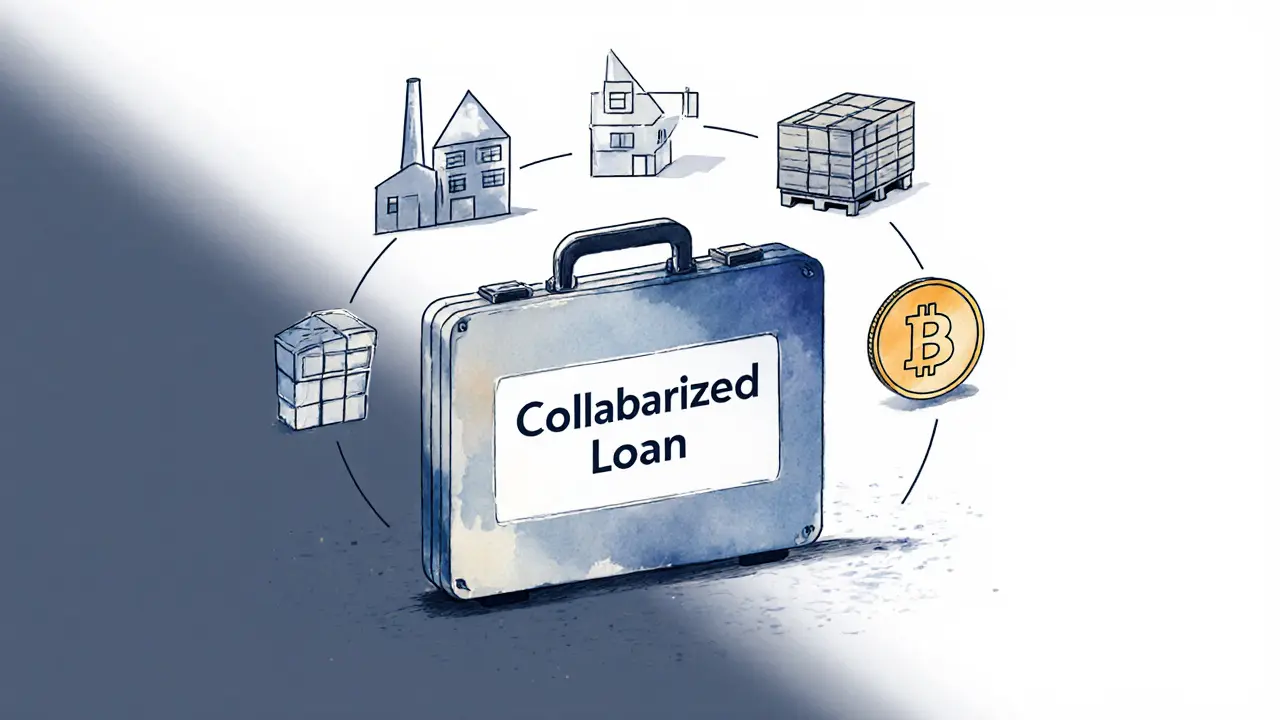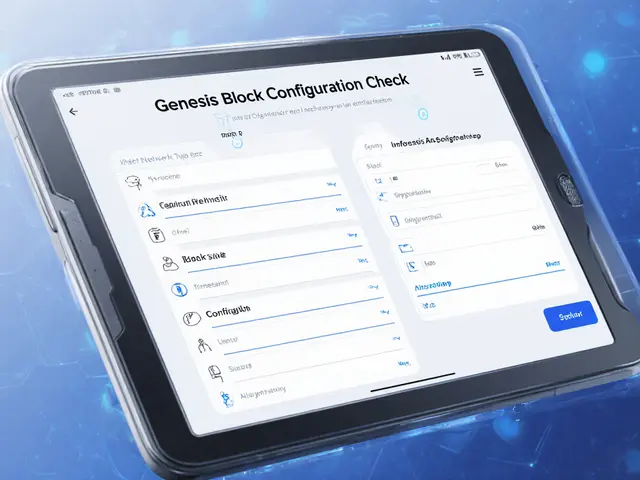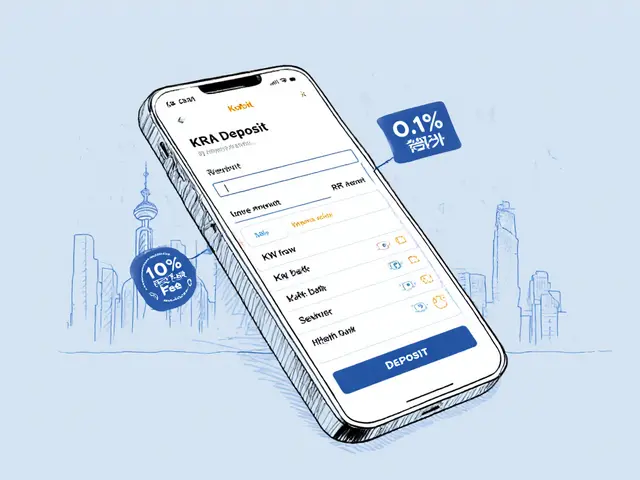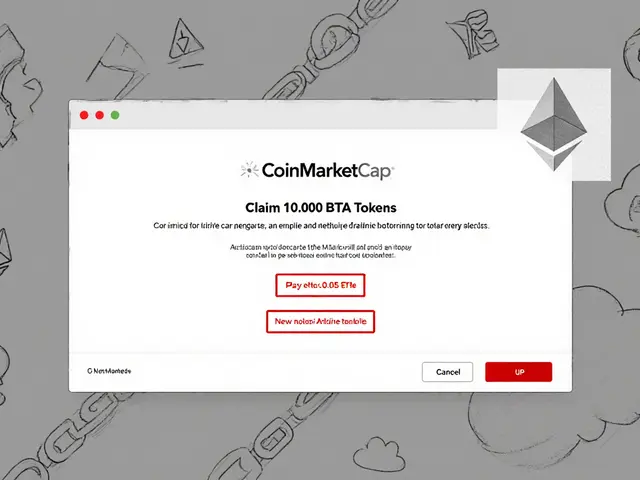Collateralized Loan Liquidation Pathway Explorer
Select a loan type and click "Explore Liquidation Process" to learn about its specific liquidation pathway.
When a borrower can’t meet payment obligations, the lender must turn the loan into cash - that’s the collateralized loan liquidation process. Whether you’re dealing with a government‑backed SBA loan, a high‑yield CLO, or a trustless DeFi protocol, each path follows its own set of rules, paperwork, and technology. Below we break down the key steps, the players involved, and the pitfalls to avoid so you can navigate any liquidation with confidence.
What Exactly Is a Collateralized Loan?
Collateralized loan is a credit arrangement where the borrower pledges an asset - real estate, equipment, inventory, or digital tokens - as security for the loan amount. If the borrower defaults, the lender can seize and sell the pledged asset to recover the outstanding balance. This basic premise underpins three very different ecosystems that we’ll explore: traditional government‑backed loans, structured finance products like CLOs, and blockchain‑based DeFi platforms.
Traditional Government‑Backed Loan Liquidation (SBA 7(a) Example)
SBA 7(a) loan is a U.S. Small Business Administration loan program that guarantees up to 85% of the principal, helping small firms secure financing they might otherwise be denied. When a borrower defaults, lenders must follow a strict set of steps defined by the SBA’s Standard Operating Procedures (SOP).
- Step 1 - Notification: Lender files a default notice with the SBA and begins internal collection efforts.
- Step 2 - Collateral appraisal: An independent appraiser determines the fair market value of the secured asset.
- Step 3 - Sale or foreclosure: Depending on asset type, the lender either conducts a public auction or files a foreclosure action.
- Step 4 - Recovery reporting: All proceeds, expenses, and remaining balance are reported to the National Guaranty Purchase Center (NGPC).
- Step 5 - Charge‑off and guaranty claim: If the loan is fully recovered, the lender notifies the NGPC (code “6” on the 1502 report). If not, the lender files a claim for the SBA‑guaranteed portion.
Any deviation from the SOP - like selling the asset too quickly or failing to document expenses - can reduce the SBA’s purchase amount, leaving the lender with a larger loss. Because the SBA guarantees most of the loan, compliance is not just a best practice; it’s a financial necessity.
Collateralized Loan Obligations (CLO) Liquidation Mechanics
Collateralized Loan Obligation (CLO) is a securitization vehicle that bundles a diversified pool of senior‑secured corporate loans and issues tranches of debt to investors. CLOs are managed by a collateral manager who buys, sells, and re‑invests cash flows throughout three distinct periods:
- Reinvestment period (up to 5 years): New loan purchases are funded by incoming principal payments.
- Non‑call period (6-24 months): Equity holders cannot call or refinance the debt, providing stability for senior tranches.
- Amortization period: Cash flows are used to pay down the outstanding debt, eventually leading to maturity.
If the underlying loan pool underperforms - say a cluster of borrowers defaults - the CLO enters a liquidation phase. The manager typically follows a “waterfall” that first pays senior tranche holders, then mezzanine, and finally equity. This hierarchy is backed by credit enhancements such as over‑collateralization and reserve accounts, which absorb early losses and often keep senior ratings intact even during market stress.
Decentralized Finance (DeFi) Automated Liquidation
Decentralized Finance (DeFi) is a blockchain‑based ecosystem that offers lending, borrowing, and trading without traditional intermediaries. Liquidations run automatically via smart contracts when a borrower’s collateral ratio drops below a protocol‑defined threshold, often set around 110%.
- Trigger: The protocol continuously monitors loan‑to‑value (LTV) ratios. As market prices shift, the collateral ratio is recalculated in real time.
- Execution: Once the ratio breaches the limit, the smart contract seizes the collateral and offers it to liquidators via an auction or direct swap.
- Fees: Many platforms charge a liquidation fee (e.g., 5% of seized collateral) to incentivize liquidators. However, excessive fees - sometimes as high as 30% - can deter participation and leave bad debt on the books.
Technical robustness is critical. A well‑designed protocol refreshes all accrued interest, funding fees, and P&L calculations before checking eligibility, preventing “dirty” liquidations where users are unfairly penalized. Grace periods after an unpause event also give borrowers a short window to add more collateral before the engine fires.

Regulatory & Legal Landscape
Traditional loan liquidation is governed by federal statutes, state law, and agency guidelines. In Florida, for example, the SBA’s rules intersect with state foreclosure statutes, meaning lenders must file the correct legal notices and honor borrower rights to redemption where applicable. Failure to comply can trigger lawsuits, reputational damage, or loss of future SBA guaranty eligibility.
DeFi, on the other hand, operates in a regulatory gray zone. U.S. regulators have signaled that protocols facilitating “exchange‑like” liquidation may fall under commodity or securities rules, especially if the platform earns fees from the process. Until clearer guidance arrives, many DeFi projects adopt self‑imposed compliance - KYC, AML checks, and transparent fee structures - to mitigate regulatory risk.
Best Practices & Risk Management Across All Models
Regardless of the structure, a solid liquidation plan shares common pillars:
- Documentation: Keep detailed records of asset appraisals, communication logs, and cost breakdowns. This speeds up claim filing for SBA guarantees and provides audit trails for investors.
- Timely Action: Early detection of default signals lets lenders negotiate workouts before full liquidation becomes necessary.
- Cost‑Effective Sale: For physical assets, use reputable auction houses; for digital assets, employ reputable DEX aggregators to avoid slippage.
- Legal Review: Ensure that foreclosure notices, lien releases, and smart‑contract code are vetted by counsel familiar with both traditional and crypto law.
- Technology Integration: Deploy real‑time monitoring dashboards that pull market data, calculate collateral ratios, and flag breaches automatically.
In the DeFi world, adding a “cool‑down” period after a protocol upgrade can prevent sudden spikes in liquidation events that catch users off‑guard. For CLOs, maintaining adequate credit enhancements and conducting stress‑tests under adverse macro‑economic scenarios helps protect senior tranche investors.
Quick Comparison of liquidation approaches
| Aspect | SBA 7(a) Loan | CLO | DeFi Protocol |
|---|---|---|---|
| Governing rules | Federal SOPs, state foreclosure statutes | Securitization indentures, credit‑enhancement covenants | Smart‑contract code & community‑voted parameters |
| Trigger event | Borrower default, missed payments | Excessive loan‑pool losses, breach of covenants | Collateral ratio < 110% (or protocol‑specific) |
| Recovery method | Asset appraisal → public auction/foreclosure | Asset sell‑down according to waterfall hierarchy | Automated auction or direct swap on-chain |
| Fees & costs | Legal, appraisal, marketing expenses (often reimbursable) | Liquidity provider fees, reserve account usage | Liquidation fee (typically 5‑10% of seized collateral) |
| Regulatory oversight | SBA & state regulators | Securities‑law compliance, rating agency oversight | Emerging crypto regulator guidance, self‑governance |
| Typical timeline | 30‑90 days from default to sale | Months to years, depending on tranche and cash‑flow | Seconds to minutes after breach detection |
Next Steps for Lenders and Borrowers
If you’re a lender, start by mapping each loan type in your portfolio to its specific liquidation protocol. Build a checklist that includes appraisal vendors, legal counsel contacts, and, for digital assets, a reliable price‑oracle provider. For borrowers, keep an eye on your loan covenants - a modest dip in collateral value can trigger a cascade of actions if you’re not prepared.
Both sides benefit from open communication. Negotiating a brief repayment holiday can avoid the costly, reputation‑damaging public auction that the SBA SOPs demand. In DeFi, adding a small buffer above the minimum collateral ratio (say 130% instead of 110%) gives you a safety net against market swings.
Frequently Asked Questions
What happens if an SBA‑guaranteed loan is fully recovered?
The lender must notify the National Guaranty Purchase Center, update the loan’s status to code “6” in the monthly 1502 report, and submit final documentation confirming that the guaranty portion has been released.
Can a borrower stop a DeFi liquidation after it’s triggered?
Only if the protocol includes a grace period or if the borrower quickly adds enough collateral to push the ratio back above the threshold. Once the smart contract executes the seizure, it’s irreversible.
Do CLO investors ever lose money in a liquidation?
Senior tranche holders are usually protected by over‑collateralization and reserve accounts, but mezzanine and equity investors can see significant losses if the underlying loan pool experiences widespread defaults.
What are the most common reasons for a loan default that leads to liquidation?
Cash‑flow problems, sudden market downturns that erode collateral value, and poor financial management are the top three triggers. For DeFi, rapid crypto‑price drops are a frequent cause.
How can lenders reduce the cost of liquidation?
By conducting early risk assessments, using reputable appraisal firms, documenting all expenses for potential guaranty claims, and, in the crypto space, choosing protocols with transparent fee structures and high‑liquidity markets.






Jared Carline
28 October, 2024 . 06:11 AM
The SBA 7(a) liquidation protocol mandates a strict notification sequence before any asset disposition can occur.
Failure to file the default notice with the NGPC immediately triggers compliance reviews that can delay recovery.
Appraisers must be independent and certified to ensure the fair market value is defensible under federal guidelines.
Public auctions, when employed, must adhere to state-specific notice periods to avoid legal challenges.
Adhering to these steps preserves the guaranty eligibility and mitigates lender exposure.
raghavan veera
28 October, 2024 . 14:31 PM
When you think about collateral, it's basically trust quantified into something you can sell later.
Each loan type reflects a different philosophy of risk – the government leans on paperwork, while DeFi trusts code.
That contrast shows how finance evolves from human judgment to algorithmic enforcement.
The liquidation steps become a story of how quickly we let machines replace human oversight.
In the end, both systems aim to turn default into cash, just via different languages.
Understanding that helps you see the underlying symmetry across the models.
It's fascinating how the same principle underlies such varied mechanisms.
Sumedha Nag
28 October, 2024 . 22:51 PM
The DeFi liquidation model feels like a wild west showdown.
Holly Harrar
29 October, 2024 . 07:11 AM
Quick tip: when you’re prepping for an SBA liquidation, make sure you’ve got a reliable appraiser on standby – they’ll save you a ton of paperwork headaches.
Also, keep all your legal notices organized in a folder; you’ll thank yourself when the NGPC asks for docs.
Don’t forget to double‑check the state‑specific foreclosure rules, they vary a lot and can add unexpected delays.
Vijay Kumar
29 October, 2024 . 15:31 PM
The CLO waterfall is like a cascade where senior tranches get paid first, and only the leftovers trickle down.
Because of over‑collateralization, senior investors often stay insulated even when underlying loans start defaulting.
However, mezzanine and equity holders bear the brunt of any loss, which is why they demand higher yields.
During a liquidation, the manager must sell assets in the order dictated by the indenture, respecting any lock‑up periods.
Having a clear stress‑test scenario helps the manager decide when to start the sell‑down before the pool’s health deteriorates further.
Edgardo Rodriguez
29 October, 2024 . 23:51 PM
Consider, for a moment, the sheer complexity, of the automated DeFi liquidation engine, which monitors collateral ratios, updates accrued interest, and triggers smart contracts, all in real time.
Such systems must be meticulously coded, audited, and continuously upgraded, or else they risk cascading failures.
The beauty lies in the transparency, but the danger resides in the rigidity, of code that cannot adapt to unforeseen market shocks.
mudassir khan
30 October, 2024 . 08:11 AM
The article glosses over the operational costs associated with SBA foreclosures, which are anything but negligible.
It fails to acknowledge that many lenders lack the internal expertise to navigate the requisite SOPs, resulting in delayed recoveries and reduced guaranty payouts.
This omission undermines its utility for practitioners who need a realistic view of the financial burden.
Bianca Giagante
30 October, 2024 . 16:31 PM
While the procedural details are dense, maintaining meticulous records as suggested can streamline the claim process and protect against potential compliance penalties.
Andrew Else
31 October, 2024 . 00:51 AM
Oh great, another deep dive into loan paperwork – just what I needed on a Saturday night.
Susan Brindle Kerr
31 October, 2024 . 09:11 AM
Reading about liquidation feels like watching a high‑stakes drama where every missed step becomes a cliffhanger, and the stakes are nothing short of a lender’s reputation on the line.
Danielle Thompson
31 October, 2024 . 17:31 PM
Good summary! 👍 Keep the steps clear and concise. 😊
Eric Levesque
1 November, 2024 . 01:51 AM
We need stricter rules on DeFi liquidations to protect everyday investors.
alex demaisip
1 November, 2024 . 10:11 AM
The liquidation mechanisms across SBA loans, CLO structures, and DeFi protocols share a common objective: converting a defaulted obligation into recoverable cash, yet the execution pathways diverge significantly due to regulatory, structural, and technological constraints.
In the SBA 7(a) context, the process is anchored in a federally mandated sequence that begins with a default notice, proceeds through an independent appraisal, and culminates in a public auction or foreclosure, each step meticulously documented to satisfy the NGPC’s reimbursement criteria.
Compliance failures at any juncture, such as an improperly filed notice or an undervalued appraisal, can trigger a reduction in the guaranty amount, thereby increasing the lender’s exposure.
Conversely, CLO liquidation operates under the governance of indenture agreements, where the collateral manager must honor the waterfall hierarchy, prioritizing senior tranche payments before allocating any residual proceeds to mezzanine and equity holders.
The presence of credit enhancements, like over‑collateralization and reserve accounts, serves as a buffer that often preserves senior tranche values even amid significant loan pool deteriorations.
When defaults exceed predefined thresholds, the manager initiates asset sales, which may involve secondary market transactions or bespoke auctions, all while adhering to covenants that restrict timing and pricing to protect tranche interests.
DeFi protocols, by contrast, automate liquidation through smart contracts that continuously monitor loan‑to‑value ratios against protocol‑defined thresholds, typically around 110 percent.
Upon breach, the contract seizes collateral and either auctions it on a decentralized exchange or executes a direct swap, charging a liquidation fee that incentivizes external liquidators to participate.
The immediacy of this process, often completing within seconds, eliminates human delay but introduces new risks such as oracle manipulation, flash loan attacks, and fee volatility.
Regulatory oversight varies dramatically: SBA processes are subject to federal statutes and state foreclosure laws, CLOs fall under securities regulations and rating agency scrutiny, while DeFi operates in a gray zone with emerging guidance from commodity and securities regulators.
Each framework therefore demands distinct risk management strategies, ranging from legal counsel and appraisal vendor selection for SBA loans, to stress‑testing and reserve management for CLOs, and robust oracle design and fee transparency for DeFi platforms.
Moreover, lenders across all models benefit from early detection mechanisms-risk dashboards, collateral health checks, and borrower engagement-to mitigate the likelihood of forced liquidation.
In practice, integrating real‑time data feeds, maintaining comprehensive documentation, and establishing clear escalation protocols are essential to preserving recovery value and regulatory compliance.
Ultimately, while the pathways differ, the shared goal remains the efficient conversion of defaulted collateral into value, underscoring the importance of tailored processes, vigilant oversight, and adaptive technology.
Elmer Detres
1 November, 2024 . 18:31 PM
Great breakdown! Remember to keep the monitoring dashboards user‑friendly so teams can act quickly on the signals you outlined.
Tony Young
2 November, 2024 . 02:51 AM
When a smart contract finally snaps and seizes the collateral, it’s like watching a digital guillotine drop – swift, unforgiving, and oddly poetic. 😱
Fiona Padrutt
2 November, 2024 . 11:11 AM
Our financial system should prioritize domestic lenders and protect them from these reckless DeFi experiments that jeopardize American capital.
Briana Holtsnider
2 November, 2024 . 19:31 PM
The piece overlooks the fact that many of these liquidation models are built on shaky assumptions, making them vulnerable to systemic shocks.
Corrie Moxon
3 November, 2024 . 03:51 AM
Even with those vulnerabilities, a disciplined approach and clear communication can mitigate many of the risks inherent in the process.
Jeff Carson
3 November, 2024 . 12:11 PM
It's interesting how the integration of real‑time price oracles has become a cornerstone for both traditional and crypto‑based liquidation strategies.
Anne Zaya
3 November, 2024 . 20:31 PM
Definitely a lot to chew on, especially if you're juggling multiple loan types.
Emma Szabo
4 November, 2024 . 04:51 AM
Imagine the liquidation workflow as a kaleidoscope of moving parts, each shimmering with its own hue of risk and opportunity.
Fiona Lam
4 November, 2024 . 13:11 PM
Yo, those DeFi liquidations are straight up ruthless, no mercy for anyone who slips.
OLAOLUWAPO SANDA
4 November, 2024 . 21:31 PM
I think the traditional SBA route is still the safest bet despite its paperwork.